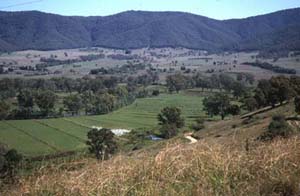IrriGate newsletter, Issue 2 summer 2009
Sustainable Irrigated Landscapes - North East – Mid/Upper Goulburn Broken
Welcome | Checking the performance of irrigation systems | Irrigation Australia Centre Pivot | Gauging interest in the federal governments ‘On-Farm Irrigation Efficiency Program’ | A break down of water use across the catchments | One Water Many Futures Conference and Irrigation Australia Exhibition | On-farm Irrigation Tool Kits | Contact Us | New Products
Checking the performance of irrigation systems
| Having an irrigation system working effectively is important for any irrigation system to maximise production, profit and to ensure efficient water use. Unless the system is performing extremely poorly it is impossible to visually tell if an irrigation system is performing at an adequate level. Testing the irrigation performance can be done for most irrigation systems. The ‘catch can’ test is one way to measure the wetting pattern under a spray irrigation system. Water collection cans are placed under the irrigation system at regular intervals. | 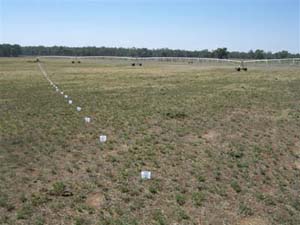 The ‘catch can’ method under a centre pivot to evaluate performance |
The results of the test can be graphed and the ‘Uniformity Coefficient’ calculated. The results in Figure 2 are from a centre pivot irrigation system put to the test. The results shows the variation of water applied along the length of the pivot. The light blue line dipping at the end is from the
end gun.
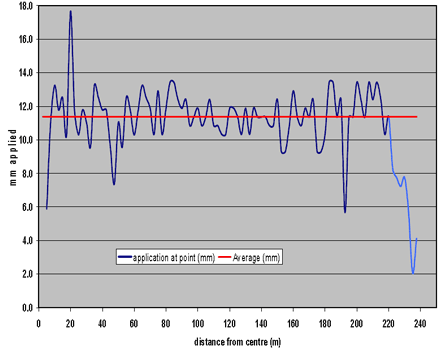
Figure 2: The variation of water applied along the length of a centre pivot. The light blue line represent the end gun.
The results from this example indicate the Uniformity Coefficient of the centre pivot is 91 per cent, which is considered adequate. In this calculation the end gun has not been included in the analysis because this operates differently to the main centre pivot.
Correct operating pressures can also be tested which may cause uniformity problems or increase pumping costs. Expressions of interest are currently being sought for any irrigators, with any system, interested in an irrigation system evaluation.
Please register your interest with either Ian Gamble if you are in North East CMA area or John Hunter for the Goulburn Broken - contact details are on the back sheet.
Irrigation Australia Centre Pivot
Irrigation Australia Centre Pivot Irrigation Performance Courses February TBA Registrations Wendy Paglia Contact details on last page
Gauging interest in the federal governments ‘On-Farm Irrigation Efficiency Program’
The Federal Government has allocated $300 million for on-farm irrigation efficiency improvements projects. Before this money can be accessed by individual farmers a body such as the CMA needs to submit a successful project proposal detailing possible water savings and numbers of participants. The aim of the program is to help pay for infrastructure improvements which result in water use efficiency gains. There is a requirement that every participating irrigator must give up at least 10 Mega Litres (ML) and at least half of their water savings. For example if capital improvements are made resulting in a saving of 40 ML, then at least 20 ML will have to be relinquished. If 12 ML is saved then at least 10 ML will have to be relinquished. At this stage we just want to determine the level of interest to possibly develop a proposal with the CMA for the second round of funding. Contact dennis.watson@dpi.vic.gov.au if you feel this program will be of benefit to you or visit the Department of the Environment and Water Resources website for further information.
A break down of water use across the catchments
Sustainable Irrigation Action Plans have been developed for the North East Catchment Management Authority (NECMA) area, and the mid Goulburn Broken and Upper Goulburn (MGB and UG) CMA areas.
These plans identified aspects of irrigation across the catchments such as location, size and sources of irrigation water. The aim of the plan is to help strategic decision making across both CMA regions and guide funding.
In the NECMA there are approximately 2,000 irrigation licences, with a total allocation of around 120,000 ML. The location of these can be seen in Figure 3. By volume 40 per cent is from regulated rivers, 30 per cent from unregulated rivers and streams, 20 per cent ground water and 10 per cent dams.
In the NE CMA it has been calculated about 70 per cent of irrigation is for pasture and fodder, viticulture comprises about 15 per cent and the remaining area is made up of a mixture of other crops and horticulture.
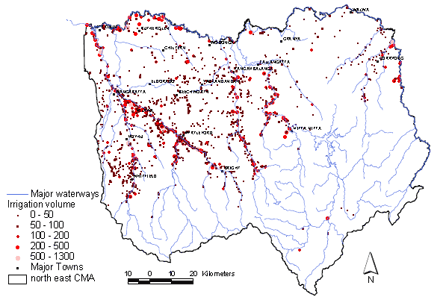
Figure 3. The location and volume of irrigation in the North East CMA
In the MGB and UG CMA region there are approximately 1,400 irrigation licences with a total allocation of 86,000 ML, the location of these and the source of water can be seen in Figure 4. By volume 62 per cent is from regulated rivers 7 per cent from unregulated rivers and streams, 19 per cent ground water and 12 per cent dams.
In the MGB and UG CMA region it has been calculated about 70 per cent of irrigation is for pasture and fodder in, viticulture comprises about 8 per cent the remaining area is made up of a mixture of other crops and horticulture
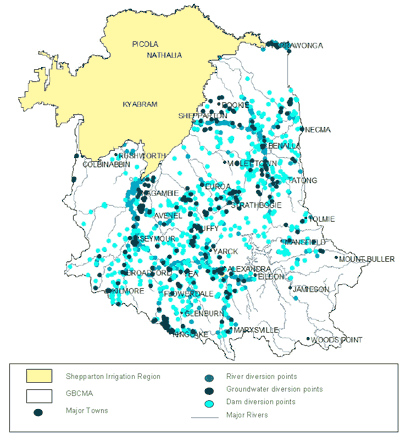
Figure 4. The location and source of irrigation in the mid Goulburn Broken and upper Goulburn CMA regions
One Water Many Futures Conference and Irrigation Australia Exhibition
The Cooperative Research Centre for Irrigation Futures (CRCIF) has joined forces with Irrigation Australia to co-host the One Water Many Futures Conference at the Sydney Convention and Exhibition Centre, Darling Harbour on June 8-10, 2010.
One Water Many Futures will be two major events in one, combining the biannual Australian Irrigation Exhibition with the conference.
The conference and exhibition will bring together irrigators, suppliers, equipment manufactures, researchers, water supply organisations, consultants, advisors and government representatives across the rural and urban irrigation industries.
The conference theme, One Water Many Futures, will look to the future of irrigation and its role in food, fibre and lifestyles as the Australian irrigation industry undergoes a policy and practice transformation.
One Water Many Futures program will include
- International and Australian plenary keynote speakers;
- Sspecialists concurrent streams;
- Symposium on regional partnerships to increase water productivity;
- Interactive poster session with guided topic tours;
- Question and answer session, hosted by ABC journalist Ticky Fullerton;
- Extended lunch in the exhibition
- Post conference tours
- Conference dinner, (included in the registration)
- Industry workshops
On-farm Irrigation Tool Kits
The CRC for Irrigation Futures will conclude its seven year term in June 2010. Over this time the CRC has achieved a great deal and it is well worth browsing through their web page. Technical notes, research findings, training opportunities are all available, including useful web based irrigation tool kits.
Contact Us
| Dennis Watson Irrigation specialist DPI Rutherglen Centre (02) 6030 4567 0429 304 567 dennis.watson@dpi.vic.gov.au |  Dennis Watson |
| Ian Gamble Catchment Management Officer DPI Wangaratta Centre (03) 5723 8671 0437 362 620 ian.gamble@dpi.vic.gov.au |  Ian Gamble |
| John Hunter Catchment Management Officer DPI Benalla Centre (03) 5761 1664 0419 363 572 john.hunter@dpi.vic.gov.au |  John Hunter |
| Wendy Paglia Project Support Officer DPI Ovens Centre (03) 5731 1206 wendy.paglia@dpi.vic.gov.au |  Wendy Paglia |
For more information please contact dennis.watson@dpi.vic.gov.au at DPI Rutherglen Centre on (02) 6030 4567. We would love your feedback and to subscribe contact wendy.paglia@dpi.vic.gov.au.
New Products
Biolab(Aust) Pty - Thermo Fisher Scientific and Crossbow Technology Inc. have released eKo™ Pro Series, a turnkey live data, wireless solar crop monitoring system enabling precision agriculture. Further information contact: 1300 736 767.
Mait Industries have announced a new product called Mini Mait by tekor™. This hand held wireless data collection system with mini radio loggers can upload data from up to 500m away and has substantial memory storage and long battery life. Radio loggers can read up to 8 x 1.6m Enviro Probes and store up to 260,0000 measurements per probe before oldest data is overwritten with current data.
Further information contact: 1300 739 920 or visit the www.mait.com.au (external link).

